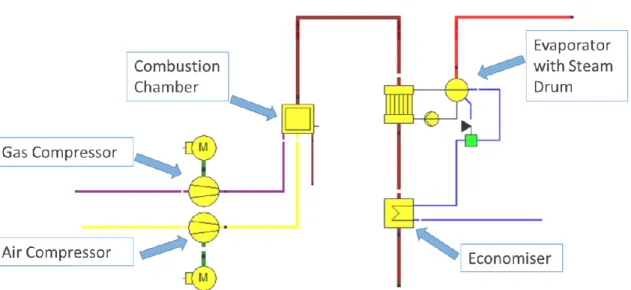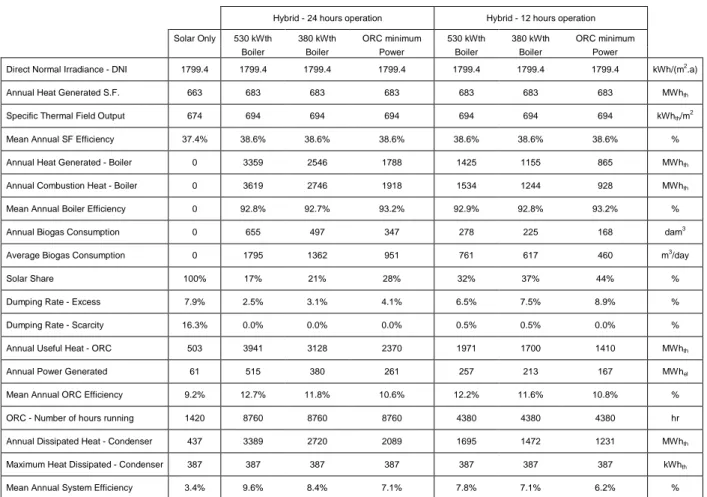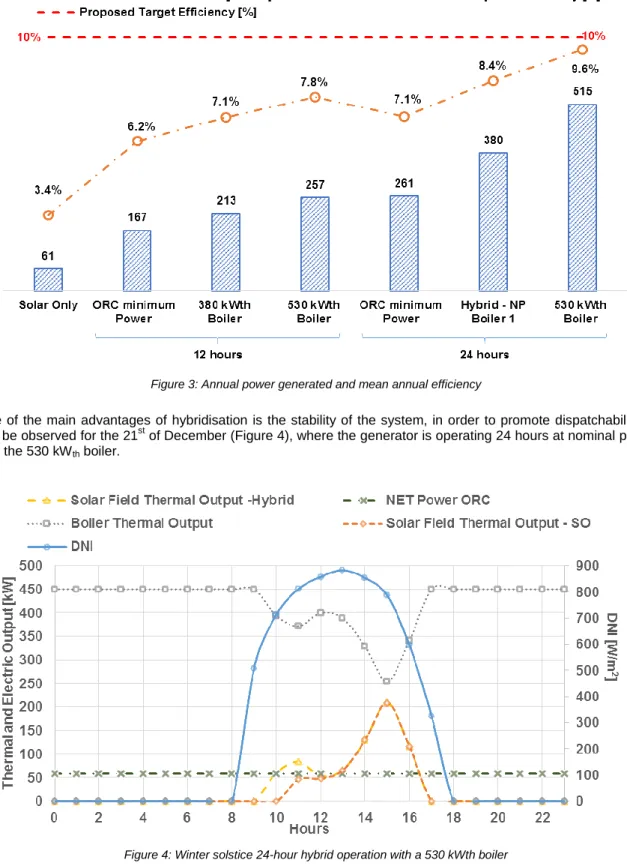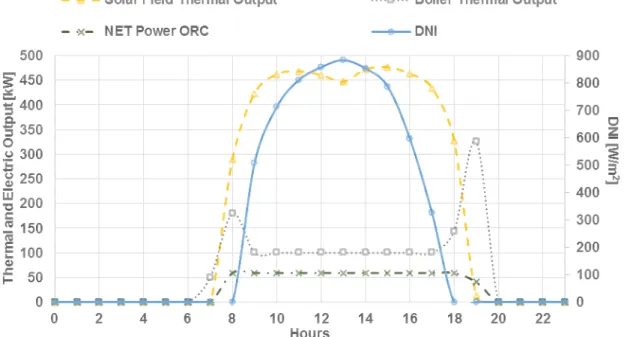Numerical Simulation of a Hybrid Concentrated
Solar Power/Biomass Mini Power Plant
João
S
OARES1,
Armando
O
LIVEIRA1,2 1Dept. Mechanical Eng. University of Porto, Rua Dr Roberto Frias 4200-465 Porto-Portugal, joaosoares@fe.up.pt
2
CIENER-INEGI, Rua Dr Roberto Frias 4200-465 Porto-Portugal, acoliv@fe.up.pt
Renewable electricity generation systems are increasingly used as a means of reducing harmful emissions and also reducing operational costs, by comparison with the use of fossil fuels. However, renewable energy sources such as solar energy are characterised by a high degree of intermittence, sometimes unpredictable. This constraint leads to inability to meet the demand of a power system. Hybridisation with more stable renewable sources, such as biomass, represents a resourceful way of meeting energy demands uninterruptedly. Besides stability, hybridisation with biomass allows a fully renewable solution, at the same time promoting security of energy supply.
In this paper, a hybrid renewable electricity generation system is presented and modelled. The system relies on a combination of concentrating solar energy (CSP) and biomass sources to drive an ORC cycle. The solar field is
constituted by 12 parabolic trough collectors with a net aperture area of 984 m2. As backup energy, a biogas
boiler is used, running on organic food waste. The nominal ORC electrical output is 60 kW. The system was designed and a prototype will be installed in Tunis, in the framework of the REELCOOP project, co-funded by the EU.
A computer model was developed with a combination of EBSILON and EES. EBSILON is used for the solar field (SF) and boiler simulations, and EES for the ORC. Annual simulations were carried out for solar-only and hybrid
modes. Distinct operation ranges and boiler sizes were analysed.
The system annual yield is significantly improved with hybridisation, with enhancement of SF and ORC efficiencies. Electrical generation stabilisation was achieved during the whole year with the fulfilment of ORC minimum requirements. On the other hand, hybridisation promoted energy excess mostly in the summer months, demonstrating that hybridisation significantly reduces, but not eradicates, the need of storage.
1. INTRODUCTION
Renewable electricity generation systems are increasingly used as a means of reducing harmful emissions and also reducing operational costs, by comparison with the use of fossil fuels. However, renewable energy sources such as solar energy are characterised by a high degree of intermittence, sometimes unpredictable. This constraint leads to inability to meet the demand of a power system. Hybridisation with more stable renewable sources, such as biomass, represents a resourceful way of meeting energy demands uninterruptedly. Besides stability, hybridisation with biomass allows a fully renewable solution, at the same time promoting security of energy supply.
Concentrated Solar Power (CSP) plants require abundant solar radiation to be feasible and profitable (Colmenar-Santos et al., 2015), abutting the implementation to remote areas, far-off power consumption centres. Furthermore, the intermittent nature of solar radiation emphasises the generation stability drawback. To overcome such issues, usually CSP plants are designed in the range of 100 MWel (Jin and Hong, 2012), with intensive
capital investment and financial risk, taking advantage from economies of scale. One of the main advantages of CSP over other renewable systems is the ability to provide dispatchable power, usually achieved through thermal energy storage (TES). Although energy dispatchability has been widely proven with TES, it is still a costly solution (Coelho et al., 2014).
Facing a huge competition from other non-dispatchable renewable energy technologies (e.g. photovoltaics) (Singh, 2013), hybridisation presents a potential solution for CSP forthcoming. Within the concept of a fully renewable power system, biomass is the ideal contender. The concept of CSP/Biomass hybridisation relies on the ability of both systems to supply thermal energy in order to drive a power generation block.
This synergy’s advantages goes further than dispatchability and renewable energy generation: operation stability and flexibility, joint use of power plant equipment (Peterseim et al., 2014) and associated cost reduction, as well as allowing CSP migration from desert areas to load centres (Moreno-Pérez and Castellote-Olmo, 2010). Furthermore, during daylight time, when electricity prices are usually higher, solar radiation is abundant and the system can run with larger solar shares resulting in a reduction of the levelised cost of energy.
In this paper, a simulation model and results for a CSP/Biomass hybrid mini power plant are presented. Annual simulations were carried out for solar-only and hybrid modes. Distinct operation ranges and boiler sizes were analysed. Simulation results are presented, such as: solar field annual generated heat and efficiency, boiler efficiency and biogas consumption, annual generated electrical energy and ORC efficiency, dumped heat, solar and biomass shares, and system global efficiency. Hourly results are presented for standard days, with and without hybridisation, showing the advantages of hybridisation.
The solar field (SF) is constituted by parabolic trough collectors (PTC) with a net aperture area of 984 m2. As backup energy a biogas boiler is used, running on organic food waste. The nominal Organic Rankine Cycle (ORC) electrical output is 60 kW. The system was designed and a prototype will be installed in Tunis, in the framework of the REELCOOP project, co-funded by the EU (REELCOOP, 2015).
2. THE HYBRID MINI POWER PLANT
The hybrid mini power plant has a nominal electrical output of 60 kW, and relies on a regenerative ORC as generation system, developed by Zuccato Energia. The turbine/generator block was adapted to assure operation at partial load, in order to compensate solar energy fluctuations, with a nominal gross efficiency reaching 13.3%. The ORC will be driven by saturated steam at 170ºC, which allows the power circuit to also operate with available waste heat. Thermal generation will be achieved either from solar energy or biomass, or from the combination of both.
The solar field relies on parabolic trough collector technology, and is constituted by 3 parallel loops of 4 PTMx/
hp-36 collectors developed by Soltigua, with a net collecting surface of 984 m2. Direct Steam Generation (DSG) will be achieved in the solar field, and the recirculation concept was adopted. The solar field will be supplied with subcooled water and partial evaporation will take place in the solar collectors. The water/steam mixture is then separated in a steam drum, and therefore only saturated steam leaves the solar field. The leftover water is then recirculated. Complete evaporation enhances control complexity, implying unnecessary risks over solar collectors’ absorbers (Krüger et al., 2014).
Auxiliary energy will be provided by a biogas steam boiler. The biogas will be produced by anaerobic digestion of canteen organic waste remains, showing a potential solution for the problem that waste disposal represents (Oliveira and Coelho, 2013). The system layout allows either hybrid or individual operation with each thermal source (solar-only or biogas-only).
In order to reduce thermal energy waste as well biogas consumption and to compensate short transients from solar power, a storage tank was foreseen in the project. Since the storage tank will be charged with saturated steam from the solar field, an isothermal latent thermal energy storage concept has been adopted. Whilst typical TES systems deal with sensible heat storage by temperature change, the latent heat solution uses Phase Change Materials (PCM).
3. SIMULATION MODEL
The developed simulation model encompasses two stages. First, the solar field, the water/steam cycle and the boiler were analysed using a commercial software: EBSILON® Professional. This stage includes the simulation of the thermal generation system, for different operation profiles.
The second stage concerns the power block circuit analysis that was carried out using EES software. The model required that relevant properties of the working fluid (SES36) were introduced, as they were not available either in the EES database or in EBSILON.
EBSILON software was designed for steady state calculations. Yet, the simulations were carried out considering the transient behaviour of the system, on an hour-by-hour basis, using a time-series function.
The simulation layout is presented in Figure 1. The solar field is constituted mainly by one loop of four parabolic trough collectors, the sun, distributing and collecting headers, and the feed and recirculating pumps. The boiler was modelled trough a heat injection component, and the regenerative ORC was simulated using EES.
Figure 1: Simulation Layout
The Sun acts as interface between the meteorological data and incident radiation on the collectors, based on DIN 5034 standard. Meteorological data were obtained using Meteonorm software for the prototype site location (Tunis, Tunisia). Heat and pressure losses on the solar field pipes and headers were considered as well. The one-loop simplification was used in order to reduce the computational effort, yet the other two loops were accounted for through the use of the distributing and collecting headers.
The solar collectors were modelled with EBSILON´s line focusing solar collector component and manufacturer´s technical information. The solar field thermal inertia and transient behaviour were modelled through the use of an indirect storage (IS) component and a time-series analysis. The use of an IS block was applied to each solar collector and both headers, where the highest thermal gradients are expected to occur.
The indirect storage component calculates the transient heat exchange between the water/steam and either the collector´s absorber tube or piping. The Fourier heat transfer differential equation is discretised in a two-dimensional domain using a finite volume method, and in time by an iterative Crank-Nicholson method (Pawellek et al., 2012). As inputs, the IS block requires the estimated values for the water and steel mass, as well as the inner heat transfer coefficient at design conditions.
Hybridisation was modelled trough a heat injection component, representative of the boiler. This component acts as an ideal heat exchanger, promoting the interface between the boiler output and the mass flow rate of water/steam. In order to control the boiler output, a code was created using EbScript to impose operating limits according to the manufacturer data. The boiler output is controlled by the water/steam mass flow rate, acting as an auxiliary heater of the solar field. For simulation purposes, the Viessmann VITOMAX 200-HS model with economiser was used. Two different boiler sizes were the object of analysis, with nominal heat outputs of 380 kWth (0.5 ton/hr of saturated steam) and 530 kWth (0.7 ton/hr of saturated steam), and both with a minimum thermal output of 100 kWth. The transient behaviour of the boiler was considered using the IS component, taking into account that the boiler takes half an hour from cold start to design conditions.
For estimating biogas consumption, a computer model was created using Ebsilon, consisting in a combustion chamber where the mix of air and biogas is burned, retrieving as output the flue gas. The combustion was modelled considering an excess of oxygen in the flue gas of 3%. The control of biogas and air mass flow rate is achieved considering manufacturer’s data regarding efficiencies and flue gas temperatures, either for nominal or part load conditions. The flue gas exchanges heat with a steam evaporator and economiser (see Figure 2).
Figure 2: Boiler simulation layout
Biogas consumption was estimated considering a yearly constant low heating value (19.27 MJ/m3). A study was conducted at ENIT, for estimating biogas production with the local canteen residues. The estimated value is about 60 m3/day.
The ORC sub-system was simulated using EES, since properties data of the organic fluid (SES36) were not available in the Ebsilon database. It was assumed that the ORC operates at steady-state and thermal inertia of the power block was neglected. The control was achieved through the organic fluid mass flow rate. Manufacturer´s technical information for the turbine, pump and generator efficiencies were considered. As input the code requires the saturated steam mass flow rate from EBSILON. Neither pressure drops nor efficiencies were considered for the heat exchangers. As main output results the code provides the gross and net electrical power, organic fluid mass flow rate, as well as the parasitic consumption and the condenser thermal requirements.
Solar-only operation mode
The system steam production will be controlled by the mass flow balance at the steam drum. The same concept was used in the simulation model. During system operation the recirculating mass flow rate is kept constant at about 0.5 kg/s. In real conditions the feed water pump will operate when the water level in the steam drum drops below a predefined level. Since the simulations were carried out in an hourly basis, it was assumed that the mass flow rate of the feed water should balance the water removed from the recirculating pump, and so is intrinsically related to the steam quality after the distributing header.
If the saturated steam mass flow rate that leaves the solar field exceeds the maximum requirements of the ORC, it is then separated. In real operation, the solar collectors should change their state to partial defocused in order to
control the steam production. In the simulation model, the excess of energy is accounted as dumped, providing an input for a PCM storage tank design. The last separation occurs before the ORC, through a water-steam drainer. This component is mostly used in the warm-up and cool-down profiles, to establish a more realistic thermodynamic balance.
To obtain a more accurate approach in the simulation model, distinct operating profiles were created. A code was developed using EbScript to allow the automatic interchange between the profiles using dynamic variables, e.g. direct normal irradiation, hour of the day.
The solar only operating mode is constituted by four profiles: warm-up, operating, cool-down and stop. At the beginning of the day if DNI exceeds 200 W/m2 the collectors change their state to focus and the recirculating pump is activated. This represents the warm-up profile. The operation profile starts with solar field steam production, and operates as described before.
At the end of the day, if DNI is less than 200 W/m2, the collectors change their state to defocus and water circulates until the system cools-down. At night, the system is off, with solar field collectors defocused and the pumps shut-down. Even during the night, the thermal inertia of the system as well as the heat losses to the ambient were considered.
Hybrid operation mode
The analysis was carried out based on the assumption of the system running 12 or 24 hours daily, at ORC minimum and nominal power. Concerning the control, the hybrid mode comprehends four and two operating profiles for the 12 and 24 hours regimes, respectively. The 12-hour operating regime differs from the solar only, on the warm-up and operating profile.
The warm-up begins at 7:00 with the start of the boiler in order to warm-up the ORC and the feed water line of the solar field. If DNI exceeds 200 W/m2 the recirculating pump is activated and the solar collectors focused. During the operation regime (08:00 to 20:00) the hybrid mode is activated, where the boiler compensates the requirements (nominal or minimum) to drive the ORC turbine. This control is achieved by saturated steam flow rate balance. In preliminary simulation results it was noticed that during summer the system could start earlier (at 7:00), and the 12 hour operation regime acted as constraint to the solar field. To overcome this issue, in the beginning of the day if DNI is above 200 W/m2 the collectors are focused earlier.
The 24-hour regime just encompasses two operation modes, hybrid and boiler-only. During the daylight period the system operates in hybrid mode, and at night the collectors are defocused and the solar field is cooled down. After that the system relies solely on the boiler.
For both cases the boiler minimum power of 100 kWth was considered, in order to assure electricity generation stability, during the predefined time operating range. Otherwise, the boiler would be submitted to consecutive startups and shutdowns, and shortages in the electrical generation would be expected, due to solar radiation transients.
4. RESULTS
If the system relies solely on solar energy the annual heat generated is about 663 MWhth.Hybridisation improved
the solar field output by 3% (Table 1). This outcome is related with the system start-up, since the SF feed water is already warmer, and consequently less solar energy is required to achieve steam generation. Furthermore, this improvement is extended to the solar field annual efficiency.
The second improvement of hybridisation was the extinction of dumping rates associated with scarcity of energy. Almost one quarter of the heat is dumped in the solar-only operation mode, mostly related with energy dearth. The dumping rate results are divided in two items (excess and scarcity), representing the heat dumped due to the excess of energy or due to insufficient energy to drive the ORC turbine, respectively.
The scarcity of energy was surpassed with hybridisation, with the fulfilment of the ORC minimum thermal power requirements. On the other hand, the excess of energy increased. This fact is related with minimum operating conditions of the boiler (100 kWth), leading to energy waste predominantly in the summer months, when solar
radiation is highly available.
The excess of energy can be reduced by implementing a storage tank in the system. The benefits extend beyond the ability to store the excess of solar field thermal energy. If storage capacity can provide more than 30 minutes of thermal energy requirements to drive the ORC turbine, the need of having the boiler in permanent operation is
eliminated. In other words, it can act as system buffer in order to compensate thermal output fluctuations from the solar field and boiler, reducing the amount of wasted biogas.
Despite the discontinuous operation of the boiler, due to the solar irradiance transients, the average biogas boiler efficiency is still high (about 93%) for all cases.
Table 1: Simulation Annual Results
Hybrid - 24 hours operation Hybrid - 12 hours operation
Solar Only 530 kWth 380 kWth ORC minimum 530 kWth 380 kWth ORC minimum
Boiler Boiler Power Boiler Boiler Power
Direct Normal Irradiance - DNI 1799.4 1799.4 1799.4 1799.4 1799.4 1799.4 1799.4 kWh/(m2.a)
Annual Heat Generated S.F. 663 683 683 683 683 683 683 MWhth
Specific Thermal Field Output 674 694 694 694 694 694 694 kWhth/m
2
Mean Annual SF Efficiency 37.4% 38.6% 38.6% 38.6% 38.6% 38.6% 38.6% %
Annual Heat Generated - Boiler 0 3359 2546 1788 1425 1155 865 MWhth
Annual Combustion Heat - Boiler 0 3619 2746 1918 1534 1244 928 MWhth
Mean Annual Boiler Efficiency 0 92.8% 92.7% 93.2% 92.9% 92.8% 93.2% %
Annual Biogas Consumption 0 655 497 347 278 225 168 dam3
Average Biogas Consumption 0 1795 1362 951 761 617 460 m3/day
Solar Share 100% 17% 21% 28% 32% 37% 44% %
Dumping Rate - Excess 7.9% 2.5% 3.1% 4.1% 6.5% 7.5% 8.9% %
Dumping Rate - Scarcity 16.3% 0.0% 0.0% 0.0% 0.5% 0.5% 0.0% %
Annual Useful Heat - ORC 503 3941 3128 2370 1971 1700 1410 MWhth
Annual Power Generated 61 515 380 261 257 213 167 MWhel
Mean Annual ORC Efficiency 9.2% 12.7% 11.8% 10.6% 12.2% 11.6% 10.8% %
ORC - Number of hours running 1420 8760 8760 8760 4380 4380 4380 hr
Annual Dissipated Heat - Condenser 437 3389 2720 2089 1695 1472 1231 MWhth
Maximum Heat Dissipated - Condenser 387 387 387 387 387 387 387 kWhth
Mean Annual System Efficiency 3.4% 9.6% 8.4% 7.1% 7.8% 7.1% 6.2% %
As expected, electric generation significantly increased with hybridisation. If the system depends only on solar energy, electric generation is limited to 1420 hours and 61 MWhel, and confined to summer months. In spite of the
favourable Tunisian climate, solar radiation monthly values show a noteworthy discrepancy between summer and winter. To enable electrical generation in low radiation months, the solar multiple should be increased leading to costly and oversized systems. On the other hand, even system hybridisation for 12 hours/day at ORC minimum power showed an annual generation of 167 MWhel, with a solar share of 44%.
System annual efficiency experienced a huge boost with hybridisation, from 3.5% to almost 10%, due to the high efficiency boiler, along with improved efficiencies of the SF and ORC (Figure 3). In the REELCOOP framework a 10% system efficiency was proposed as target, which is nearly attainable with hybridisation.
Figure 3: Annual power generated and mean annual efficiency
One of the main advantages of hybridisation is the stability of the system, in order to promote dispatchability. It can be observed for the 21st of December (Figure 4), where the generator is operating 24 hours at nominal power with the 530 kWth boiler.
Figure 4: Winter solstice 24-hour hybrid operation with a 530 kWth boiler
On 21st of December, the boiler is supplying 450 kWhth until 9:00am, fulfilling the ORC requirements during night
operation. At this time the DNI is above 200 W/m2, and the collectors change their sate to focus. Steam production from the solar field starts at 10:00 am, with a thermal output of about 50 KWth. When compared with
solar-only, the steam generation starts one hour later and with half of the hybrid production. During the day the solar field is unable to supply the minimum conditions to drive the ORC turbine. Nevertheless, it contributes to a reduction in the amount of required boiler energy and biogas consumption.
On the Summer solstice (21 June), the generation stability was attained even with the smaller boiler (Figure 5). However, the heat dumped due to excess of energy increased. In such days, the boiler should be used only
during start-up and shut-down, reducing the amount of biogas consumption and heat dumped. The boiler starts to operate at 07:00, at minimum power in order to warm-up the SF and ORC. From 8:00 to 20:00 nominal electricity generation is achieved mostly from solar energy.
Figure 5: Summer solstice 12-hour hybrid operation with a 380 kWth boiler
Either Summer or Winter solstice results, showed that electricity stabilisation can be achieved during the daylight period through hybridisation, moreover with a significant solar share in the summer (75%) and less relevant (13%) in the winter. This synergy is noteworthy, since during the daylight period electricity prices are usually higher, related to peaks in network consumption.
The estimated biogas production of 60 m3/day is far below the consumption results. On an annual basis the excess of energy related with the boiler minimum operating conditions represents 738 hours of operation and 14 dam3 annual. If we consider as example the case of 12 hours of operation at minimum power, this represents 9% of the annual biogas consumption and 16% of the running hours. This represents a small contribution to CSP/Biomass hybridisation. Despite hybridisation allowing to relocate a power plant near urban centres where organic wastes are more abundant, the absence of a well-established biomass market represents a drawback to the dissemination of these systems (Colmenar-Santos et al., 2015).
As aforementioned, either solar-only or hybrid operation results showed excess of thermal energy, mostly in the summer months when solar radiation is abundant. The energy waste can be overcome with a storage tank. To define the ideal storage capacity the daily average values of the heat dumped due to energy excess were analysed for the solar-only mode (Figure 6). The analysis was not extended to hybrid mode, since it enhances the heat dumped and consequently the storage capacity. Furthermore, this overestimation can easily be eliminated with a small storage capacity. The maximum value for the average daily dumped heat is 332 kWhth (June) and the minimum is 10 kWhth (December). It is worthy to note that the maximum daily value of the excess heat doesn´t allow to drive the ORC at nominal power for one hour.
5. CONCLUSION
In this paper, a simulation model and results of a hybrid CSP/Biomass Mini Power Plant are presented. The simulations were carried out on an hour-by-hour basis for a typical meteorological year, considering different scenarios regarding operation regimes and boiler sizes.
If power generation is exclusively dependent on the solar field, electrical generation is mostly confined to summer months and negligible in the winter. The annual heat dumping rate ascends to almost one quarter, mostly related with the inability of the solar field to supply the minimum thermal energy to drive the ORC turbine.
System hybridisation proved to stabilise the system regarding electrical power generation during the whole year. Additionally, the downside of the dumped heat, due to scarcity of thermal energy, was surpassed. Hybridisation improvements where extended as well to the SF and ORC efficiencies. The SF efficiency increased 3% since the system is already warmer in the morning, and solar radiation is used exclusively for steam generation. The ORC efficiency increase is in the range of 15% to 38%, and was achieved by a stable operation near turbine design conditions.
On the other hand, there was an increase of the system energy excess due to the downsides of boiler start-up time (about 30 minutes) and minimum operational heat input (100 kWth). The simulated operation profiles were
created within the basis of energy dispatchability and demand response ability. Therewith, boiler operation was extended to the system operation range to compensate possible short transient from solar power. This issue can be overcome with the implementation of a storage tank. From simulation results, the maximum average daily dumped heat ascends to 332 kWhth. This value is quite small when compared with the system dimension. For
example, it doesn´t allow to run the system for one hour at nominal power. This proves that the solar field design is appropriate and hybridisation significantly reduces (although not totally eliminating) the need of storage. The improvements in the SF and ORC efficiencies, along with extended operation ranges and a highly efficient boiler, lead to a huge boost on system efficiency, which increases from 3.4% to 9.6%.
As future work, system simulations will include the implementation of a PCM storage tank. More operation strategies, biomass resources, different climatic regions and a cost analysis will be addressed. A prototype of the system is under development, and will be installed in Tunisia during late 2015, for testing during 2016/17, allowing a validation of the simulation results.
ACKNOWLEDGMENTS
The REELCOOP project receives funding from the European Union Seventh Framework Programme (FP7/2007-2013), under grant agreement nº 608466 (www.reelcoop.com). All other partners involved in the development of Prototype 3 are greatly acknowledged: German Aerospace Centre (DLR, Germany), CIEMAT (Spain), ENIT (Tunisia), Soltigua (Italy), Zuccato Energia (Italy), AES (Tunisia).
REFERENCES
COELHO, B., VARGA, S., OLIVEIRA, A. & MENDES, A. 2014. Optimization of an atmospheric air volumetric central receiver system: Impact of solar multiple, storage capacity and control strategy. Renewable Energy, 63, 392-401.
COLMENAR-SANTOS, A., BONILLA-GÓMEZ, J.-L., BORGE-DIEZ, D. & CASTRO-GIL, M. 2015. Hybridization of concentrated solar power plants with biogas production systems as an alternative to premiums: The case of Spain. Renewable and Sustainable Energy Reviews, 47, 186-197.
JIN, H. G. & HONG, H. 2012. 12 - Hybridization of concentrating solar power (CSP) with fossil fuel power plants. In: LOVEGROVE, K. & STEIN, W. (eds.) Concentrating Solar Power Technology. Woodhead Publishing. KRÜGER, D., KENISSI, A., SCHENK, H., BOUDEN, C., BABA, A., OLIVEIRA, A., SOARES, J., BRAVO, E. R.,
CHEIKH, R. B., ORIOLI, F., GASPERINI, D. & HENNECKE, K. 2014. Pre-Design of a Mini CSP plant. International Conference on Concentrating Solar Power and Chemical Energy Systems, SolarPACES 2014. Beijing, China: Elsevier.
MORENO-PÉREZ, Á. & CASTELLOTE-OLMO, P. 2010. Solar Parabolic Trough - Biomass Hybrid Plants: Features and Drawbacks. Solar Paces conference.
OLIVEIRA, A. C. & COELHO, B. 2013. REELCOOP project: developing renewable energy technologies for electricity generation. 12th Int Conf. on Sustainable Energy Technologies. Hong Kong.
PAWELLEK, R., PULYAEVRANK, S. & HIRSCH, T. Transient simulation of a parabolic trough collector in EBSILON. Solar Paces, 2012 Marrakesh, Morocco.
PETERSEIM, J. H., WHITE, S., TADROS, A. & HELLWIG, U. 2014. Concentrating solar power hybrid plants – Enabling cost effective synergies. Renewable Energy, 67, 178-185.
REELCOOP. 2015. REELCOOP project [Online]. Available at: http://www.reelcoop.com.




